-
News & Trends -
Sales -
Marketing Related Topics -
B2B Software Guides Related Topics -
Free Tools & Resources -
- About Us About Us


A cold call is a sales prospecting call to a lead who has never directly communicated with anyone from your company. The goal of the call is to make the lead curious enough about your product or service to accept another call or meeting during which you’ll qualify them further. To cold call effectively, it’s best to create a list of leads who fit your target audience, research each lead, and place personalized cold calls.
A cold call script outlines the words you’ll say on each cold call while leaving some space to allow for personalization for each lead. It helps you create a repeatable cold call process that you can test, tweak, and optimize. We created a free cold call script template for you, which you can download for free and get seven niche-specific examples to help create your own.
Our script template follows a standard cold calling structure that's outlined in our article on how to write a cold call script. The standard cold call format includes a cold opener that states the reason for calling, a quick elevator pitch, a brief needs assessment, and then any objection handling and proposition of next steps like a longer sales call, discovery call, or product demo.
The full step-by-step process for cold calling, from drafting your script to tracking your results, is below. Let's take a look at an overview of the cold calling steps before diving into each step in detail:
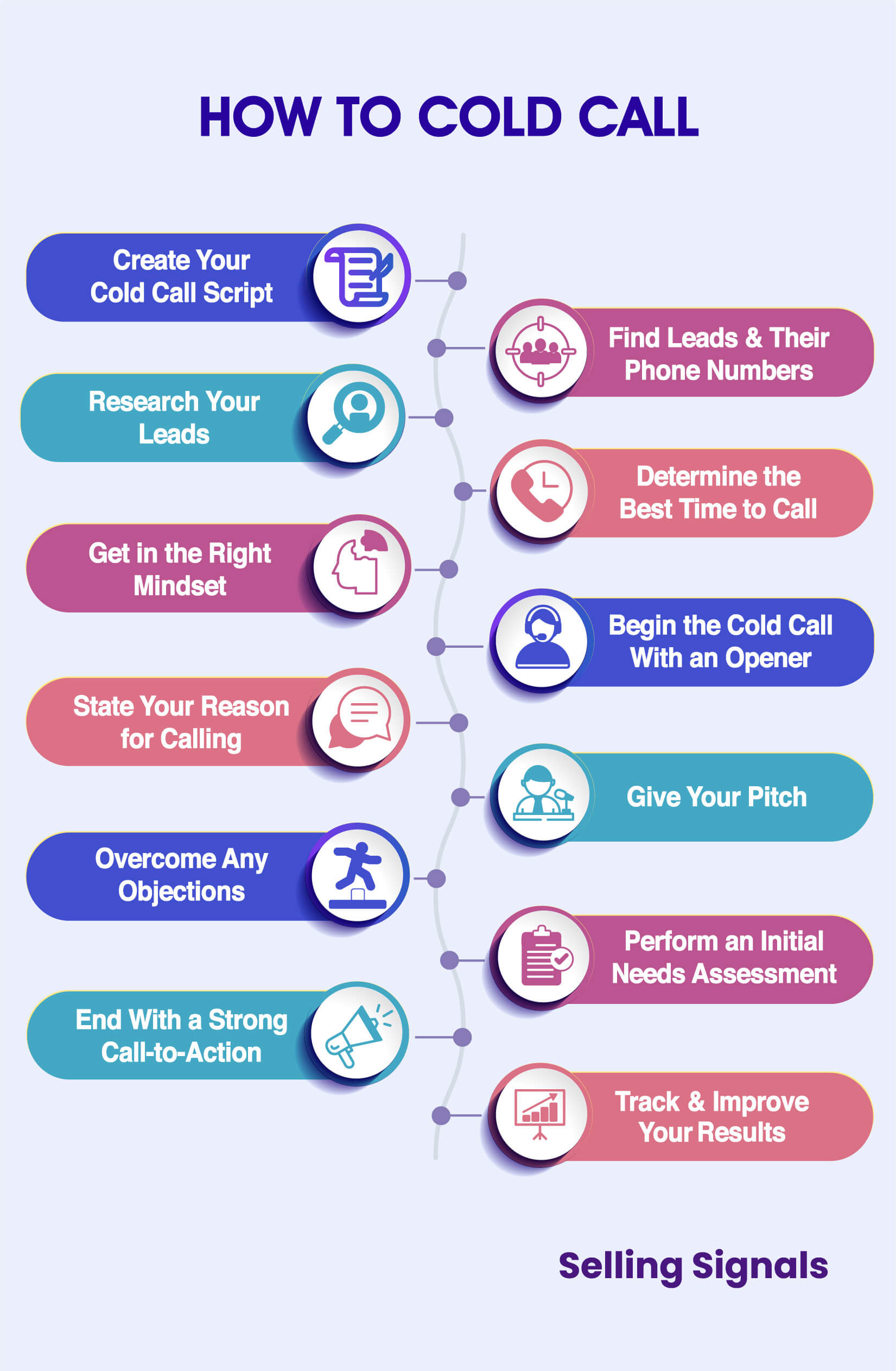
A cold call script will streamline the cold call process and allow you to to call more leads in less time and have more productive calls. Typically, the script will have an opener, your reason for calling, your unique selling proposition, rebuttals to common objections, needs assessment questions, and a call-to-action. Of course, you’ll adapt your script to fit each lead, but if you can’t find much info on a certain lead, this will still work well.
Create your own cold call script by following these steps:
In our article on how to write a cold call script, we go over each of these steps more in depth while also providing some examples of effective scripts for various cold calling scenarios.
Create a list of leads that fit your ideal customer profile, have decision-making power, and likely have the pain point you solve. Include their name, phone number, company name, title, and any other details you feel are important to know for the call. While researching the leads in the following step, you can add newfound information to it.
Assembling this list is also an act of qualification. Only let leads onto your list who fit certain criteria so you can spend your time calling people that are likely to buy your solution.
To acquire these high-potential leads, there are several methods you can use:
A list of leads should last you at least a week. So if you make 40 cold calls a day, form a list of 240. The extra 40 leads will serve as a buffer — sometimes phone numbers are inaccurate, and sometimes during the research step, you’ll disqualify leads because they don’t fit the above criteria. If you’re looking to switch up how you find phone numbers to cold call, check out our article, 11 ways to find business phone numbers, for insight on leveraging different lookup tools and social media.
If you’re reaching out to different types of companies or people, consider creating separate lists. I used to cold call VPs of property management and property managers. I therefore created two lists and wrote a script for each list, since the two roles had different pain points. One day I’d call the property manager list. The next day I’d tackle the VP list.
A personalized cold call is more effective because it makes the lead feel like your call is meant specifically for them. So, research your leads and look for information about the lead to use in your opener to build rapport (e.g., a shared hobby) and any hints about the pain points they might be having — you’ll mention these pain points after the opener of your call. Lastly, you want context, like their job title, responsibilities, or company description.
To research a lead, check the following sources:
Research the leads on your list in bulk to avoid losing momentum by stopping after every call to research the next person on the list. Add your findings next to the lead’s name for easy reference so you can personalize each call. Along the way, discard the leads that just aren’t a good enough fit for you to call. Disqualifying during the research phase is especially useful when you have access to 10,000 leads, but only enough time, and sanity, in each day to call about 50.
Now that you have a list of leads and information about them, pick the best days and times for your cold calling block(s). Typically, the times you're most likely to connect with the lead are Wednesday and Thursday at 9am local time. But your optimal time depends on your target audience’s preferences and schedule. A good way to find that is through testing.
Run a simple test to figure out the best cold calling time by following this process:
This test is an effective way to choose your benchmark cold calling time. But, a true optimal time will only become evident after you’ve collected a lot of data about connection rates with leads at certain times over the long term. In a future step, we’ll talk about tracking your cold calling success.
I would call before or after common work hours (before 9am and after 5pm) if I was trying to contact an executive. This works because they’ll likely be in the office, but their gatekeeper, typically an assistant or secretary, will not be, so the executive might answer directly. Plus, it’s unlikely other salespeople are using this strategy, so the competition is low.
Cold calling can be scary. Reps often worry about interrupting people and coming across as a nuisance. Taking proactive measures to get in the right mindset will lead to a more enjoyable and productive cold call block. And viewing yourself as a valuable problem solver keeps you motivated throughout the rejection that comes with cold calling.
To do so, think of yourself as a problem solver, and therefore a value-add to any lead on your list. Remember, you’re providing them with important intel, opening their eyes to a problem that they’re likely unaware of that’s hurting their business and life. Plus, you have the solution to it. Your leads are lucky to be receiving a call from you, and if they blow you off, that’s okay — you were simply trying to help them.
Here are some other ways to form the right mindset before a cold call block:
For more information on supercharging your mindset so you're in the right frame for making cold calls, check out our guide on overcoming call reluctance. There, you'll find the reasons for call reluctance and a repeatable strategy for getting over it.
Now it’s time to actually make a cold call, which you’ll begin with an opening line. Typically, your opener will answer the first of the two main questions on every lead’s mind: who is calling me, and why are they calling me? To do this, immediately state “Hi {lead’s name}, this is {your name} from {company name}.” Then, say something that’ll get them talking and kick off the conversation or get their permission to talk with them.
Here is our filled-out script segment on how to open a cold call:

From there, you might experience some small talk or an exchange of niceties, but the lead is still going to be hesitant to talk with you. They’re still likely skeptical of your intentions. They’re wondering “Why is this person calling me specifically?” So, in the next step, you’ll tell them.
While stating why you’re calling, you want to do three things: give the reason for your call, show the lead that your call is meant for them specifically, and come across as a knowledgeable and confident problem solver. To do all of this in one phrase, mention pain points someone in their role or industry likely suffers, including a specific pain point pertinent to this person or their company that you found during your research.
Use this completed script example to state your reason for calling:
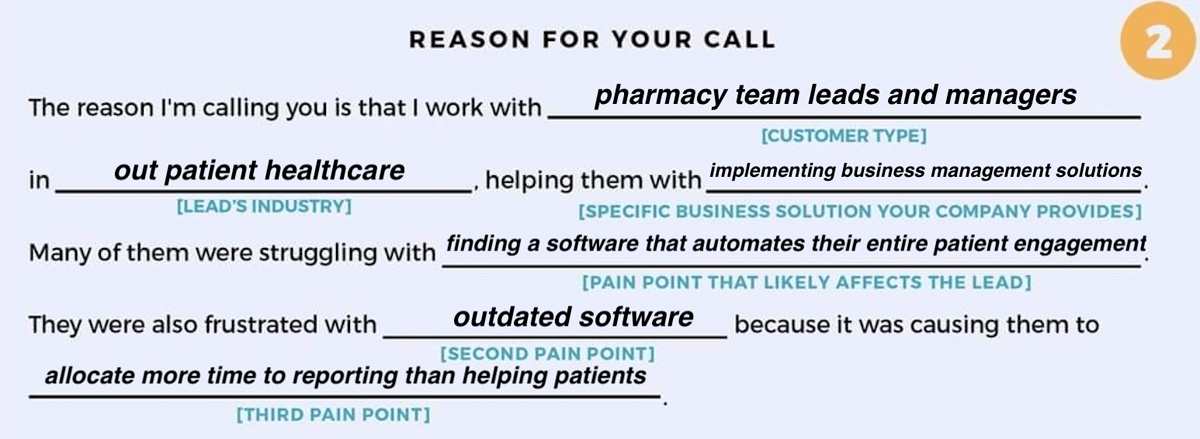
The reason for mentioning three pain points is because if you have a good understanding of the pains of your target market from your pre-call research, at least one of the pain points you mentioned will have a good chance of striking a nerve with the lead. Sometimes the lead will speak up and validate that they do in fact suffer one of these pain points, saying something like: “Yep, {pain point A} kills me.”
Other times, the lead will stay silent. In those cases, simply ask: Do any of those issues ring a bell?” Now, the sad truth is that most of your leads will just say no in an effort to end the call. That’s okay, though; if you can book a meeting with even just 1/50 of the people you call, you’re doing solid work. If your lead says yes and names a specific pain point, ask whether they want to hear how to fix it, then pitch your solution.
Next, communicate your unique selling proposition (USP) in the form of a quick elevator pitch. It should be short and succinct and clearly articulate what your product or service is and how it eliminates the specific pain point your lead is feeling. It should also name 2–3 key benefits that the lead will receive if they buy your solution. This all serves to paint your offer as valuable. The pitch should be under 30 seconds long and focus on the benefits.
Here is an example of a complete USP pitch from our cold call script:
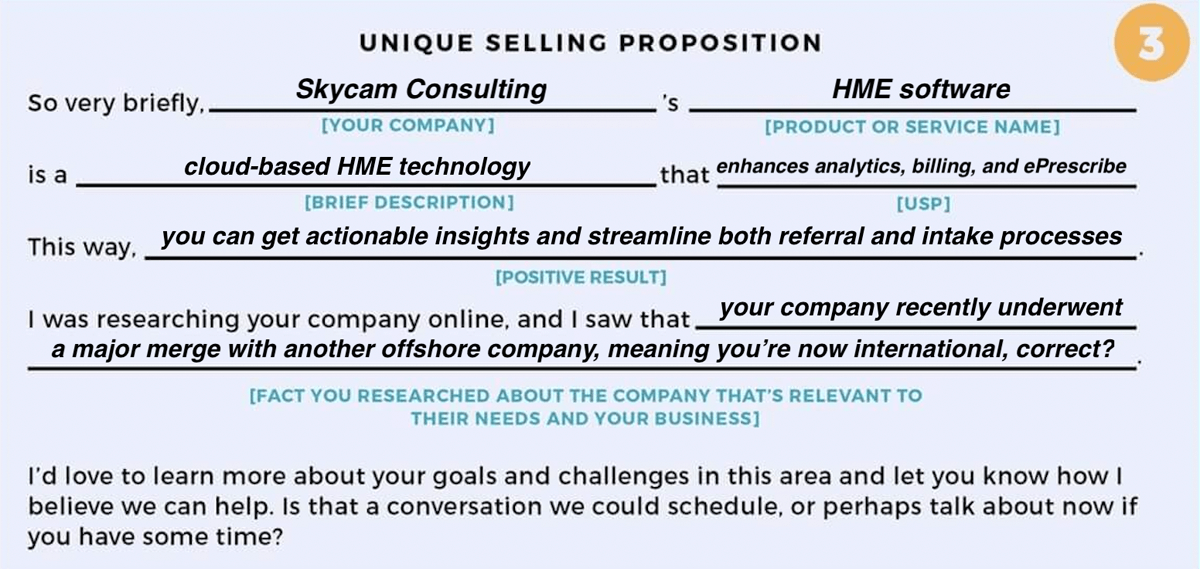
From here, your lead might ask questions that you’ll answer. Or they might just say that sounds interesting. Whatever happens, now that you’ve made your pitch, you need to overcome any objections and ask some questions to verify the lead’s fit.
If the call has gone over five minutes, plan to ask for the meeting. If they’ve dedicated that much time to hearing you out, they’re likely to accept a longer call.
You’re likely to receive objections throughout the entire cold call. However, they most commonly occur either after your pitch (refutations of your claims) or after you ask for a follow-up meeting or call. To handle objections, ask questions about their objection to gain a full understanding of why the lead isn’t interested. Once you comprehend their reasoning, show them that you hear what they’re saying, and make a rebuttal to address their concern.
Responding to an objection about limited time can be as easy as this:

The above response shows the lead you listened to their objection and are respectful of their time. It also shows that in the next meeting you’re going to see if it’s a good fit, not force the product on them. This lowers the stakes. It’s vital that you ask three times for the meeting before calling it quits. Any more and it might be overkill. Any less and you’re hurting your chances, because people tend to object two times on impulse.
If you’d like to learn more to prepare for objections, check out our article on objection handling. There, you’ll find a script for responding to leads’ common concerns, plus additional strategies and tips to help you rebut them.
By now, it should be somewhat evident whether or not the lead wants to learn more. If they engaged in a conversation about your product after you gave your pitch, they’re likely curious. Now, before you ask for the meeting, conduct a short live needs assessment to ensure they’re qualified enough for a call. Simply ask 2–3 questions to see if they actually need your solution.
Specifically, ask any of the following example questions from our cold call script:
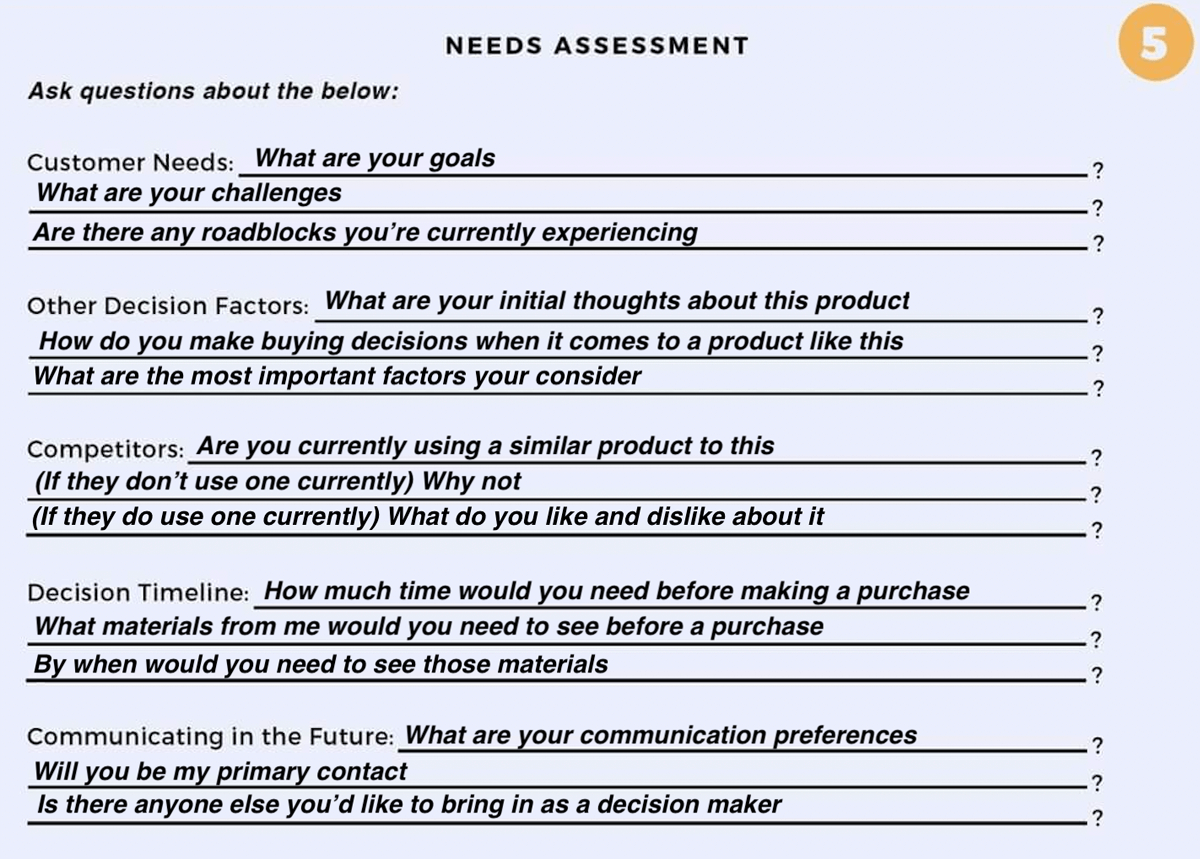
Having this information on hand will enable you to initially qualify the lead and plan a better second call with them, assuming they accept your CTA. For more information on how to execute a live needs assessment on your cold call, check out our article on how to conduct a needs assessment. There, you'll find three strategies with steps on doing it correctly.
Your CTA refers to what you want your lead to do next. You’re making a request for them to move forward in the sales process. Typically, this will be to have a meeting with you or a higher-level rep for an in-depth discovery call where you'll qualify them as a good fit. As a rule of thumb, state this CTA when you sense the lead could be interested. Perhaps they’re asking questions, engaging in conversation about the product, or just not objecting.
One of the best ways to ask for this meeting is with the following from our filled-out script is:
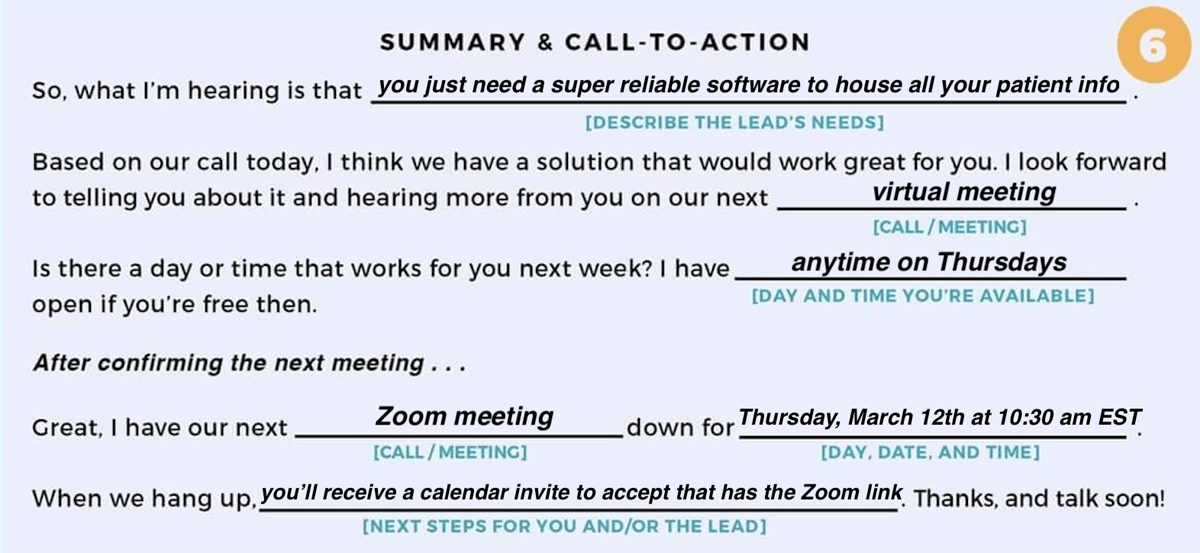
If your lead said yes and you found a time that works, consider using the end of the call to build some more rapport. Drop something you learned about them in research: “Before you go, I’ve got to mention that I saw you were in the marines. I myself served in the air force for four years. What inspired you to join?” Forming a connection will increase the odds they show up at your meeting.
Be sure to plug the outcome and each cold call into your CRM so that you can track certain metrics to see if you’re improving over time. It’ll also give you the data necessary to determine if new approaches you try are actually making a positive difference.
Specific cold calling metrics you can track include:
Tracking cold call results also forces you to confront your shortcomings and think of ways to grow. After each call, jot down notes about each call. Write any critical turning points, such as an objection you failed to overcome or a pain point you mentioned that inspired interest. After your calling block, reflect on each call by reviewing the notes. Think about those turning points, why they happened, and how you can change or replicate your actions next time.
If you don't already use CRM software, choose one to track your cold calling efforts before you start calling. While you can note your results in a spreadsheet or another method, doing so in a CRM will help you best keep track of certain cold calling metrics. As you make more calls, you'll be able to pull reports to get a full picture of how you're performing so you can figure out how to improve your results.
Regardless of whom you’re cold calling, there are some best practices you can follow to optimize the limited amount of time you have to impress your lead. Some of the most effective habits to implement are below:
Set a goal of making around 40 calls a day. Those 40 calls can be done at the same time or split between the morning and afternoon so you don’t burn out. This enables you to practice and get better while also increasing the chances you have to find prospects.
Let the conversation flow organically in order to build rapport. It can scare away leads if you sound too robotic and disingenuous over the phone. If you connect over small talk or introductions, allow time to flesh out that conversation before reengaging with your script.
Use your tone of voice to speak like a peer and project confidence and enthusiasm. If you act as if your cold calling them is a totally natural thing, they’ll believe it. This can get your lead excited to talk to you, as well.
At the end of the day, the only way you’ll get better and more comfortable at cold calling is actually picking up the phone and doing it. These tried and true tips and following our step-by-step guide will set you up for success. You’ve got this!
For more of these tips and tactics, check out our article on the top cold calling tips, each of which is backed by professional salespeople and business experts.
Generally, the best days to cold call are Wednesdays and Thursdays, and the best time to call is 9am. However, everyone’s leads are different. Your ideal day and time to place a cold call depends on their preferences and habits. So think about when they’re likely at their desks or commuting to the office with free time on their hands. Though estimating can work, the best way to figure out when to cold call is by tracking your connection rates at different times and days over the long haul.
You close a cold call by asking the lead to take certain next steps with you. Typically, that means asking them if they’re open to a discovery meeting. Here’s a phrase you can use to close any cold call: “From what I’ve heard, it seems like
{your product/service name}could really help you
{pain point they want to solve}. So I’d love to learn a bit more about your situation to further assess if we’d be a good fit. Are you open to scheduling a 20- to 30-minute meeting with me?”
Call reluctance is the resistance or fear cold callers feel when they have to call a lead. This often occurs to newer cold callers who feel burnt out from being rejected so often by leads. If you experience call reluctance, try creating and practicing a
cold call script. This script will help you feel more prepared before the call. Plus, if you practice it often, you’ll feel confident and the lines will be automatic. When you're confident in your abilities, your nerves will fade away.
Another solution is to pump yourself up before a cold call block, either with your favorite music or endorphin-inducing body language, like we discussed above in step 5. Ultimately, the best way to destroy cold call reluctance long term is to gain confidence through experience.
For more solutions, we recommended reading our article on
overcoming cold call reluctance, where we give you several practices that can help build calling momentum.
Cold calling is an effective lead generation strategy to find new business. It’s the fastest way to make a personal connection with a decision maker. If you follow the above steps, you’ll turn one of the most difficult elements of sales into one of your most valuable skills. Not only will this bring you success in sales, but it will also afford you success in life, where getting something you want often boils down to getting someone’s attention and making the ask.


Sam is a former SaaS sales rep turned freelance writer. He spent his career selling real estate technology to C-suite executives before switching over to blogging, where he now covers sales, marketing, and small business topics. Sam specializes in lead generation, lead nurturing, and deal closing articles for Selling Signals. When he’s not researching the latest sales trends, he’s either penning short stories, hiking, or reading in NYC’s Washington Square Park.

Selling Signals delivers actionable advice for sales and marketing professionals. Learn strategies that help you hit targets, strengthen customer relationships, and win more business. Get expert advice on lead generation, sales processes, CRM software, sales management, and account management directly to your inbox.
Property of TechnologyAdvice. © 2025 TechnologyAdvice. All Rights Reserved
Advertiser Disclosure: Some of the products that appear on this site are from companies from which TechnologyAdvice receives compensation. This compensation may impact how and where products appear on this site including, for example, the order in which they appear. TechnologyAdvice does not include all companies or all types of products available in the marketplace.